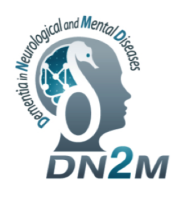



P01- Alavi Naini SM, France: Heparan sulphate is critical for tau hyperphosphorylation and tau-associated neuropathology as revealed by a zebrafish model of tauopathy.
P02- Albert M, France: Passive immunotherapeutic approaches to interfere with the spreading of Tauopathies.
P03-Allouche A, France: Human Tau oligomers-induced neurodegeneration enables tauopathy disease models for target validation and drug development.
P04-Ando K, Belgium: Alzheimer risk factor PICALM localization and protein solubilities are altered in tauopathies and are correlated with autophagy markers.
P05-Bejanin A, USA: Do gray matter atrophy or amyloid pathology contribute to the relationship between AV-1451 and cognitive symptoms in Alzheimer’s disease?
P06-Boban M, Croatia: SH-SY5Y neuroblastoma cells treated with phosphatase inhibitor okadaic acid express high molecular weight tau species.
P07-Bolognin S, Luxembourg: IPSC-derived 3D models as enabling tools for drug screening.
P08-Breuzard G, France: Tau governs cross-talk of microtubule and actin cytoskeletons necessary for cell migration in glioblastoma.
P09-Buée L, France: Hippocampal T cell infiltration promotes neuroinflammation and cognitive decline in a mouse model of Tauopathy.
P10-Buée-Scherrer V, France: Decrease in soluble Tau protein expression is a common feature of frontotemporal degeneration with progranulin mutation.
P11-Caroux E, France: Structural characterization of distinct Tau strains.
P12-Cuadrado A, Spain: Pharmacologic targeting of GSK-3 and NRF2 provides neuroprotection in a preclinical model of tauopathy.
P13-Danis C, France: Molecular characterization of VHH directed against Tau.
P14-Despres C, France: Deciphering the molecular mechanism of Tau aggregation : essential role of the triple-phosphorylated state of AT8 epitope.
P15-Devitt G, UK: Detection and characterisation of conformationally distinct tau species.
P16-Domise M, France: AMP-activated protein kinase (AMPK): a modulator of Tau phosphorylation and Tau pathology.
P17-Dujardin S, USA: Enhanced Tau Aggregation in the Presence of Amyloid Beta.
P18-Evrard C, France: VCP dysfunctions & Tau phosphorylation: a connection for neurofibrillary degeneration in Alzheimer’s disease?
P19-Faivre E, France: A2A receptor dysregulation: an instrumental role in Alzheimer’s disease?
P20-Filipcik P, Slovakia: Impaired proteostasis in cellular and animal model of tauopathy.
P21-Gilles M, France: A new role of Tau proteins in mRNA degradation by NMD pathway.
P22-Gratuze M, Canada: Tau is involved in the regulation of glucose metabolism.
P23-Guo T, UK: Molecular mechanisms underlying the development of tau pathology caused by N-terminal Tau fragmentation.
P24-Houben S, Belgium: Expression of FTDP-17 mutant tau in transgenic mice decreases adult neurogenesis in the dentate gyrus.
P25-Katsinelos T, Germany: Trans-cellular propagation of tau protein is mediated by sulfated proteoglycans.
P26-Maina MB, UK: Tau Protein: Novel interacting partner and role in the nucleolus.
P27-Malki I, France: Molecular characterization of bridging integrator 1 (BIN1) interaction with Tau.
P28-Pagano A, France: The Microtubule-associated protein Tau as a new putative therapeutic target in glioblastomas.
P29-Papanikolopoulou K, Greece: Drosophila Tau regulates Habituation & Long-term Memory.
P30-Petry FR, Canada: Alternative splicing of tau exon 10 is directly regulated by temperature and MBNL proteins family during post-embryonic development.
P31-Popova SN, Sweden: Alzheimer’s disease related pathology in the brain does not correlate with the extent of amylin in the pancreas in aged subjects with diabetes mellitus.
P32-Quinn JP, UK: Proteolytic cleavage of tau by granzyme A in dementia pathogenesis.
P33-Rábano Gutiérrez A, Spain: Can Primary Age-Related Tauopathy be identified as a coincidental finding in a brain bank series of cases?
P34-Rojo AI, Spain: NRF2 deficiency cooperates with APP and TAU pathology in Alzheimer’s disease.
P35-Rüdiger SGD, The Netherlands: Tau oligomers escape chaperone control.
P36-Sealey M, Chatterjee S, Duque M, UK: How does ageing contribute to Alzheimer’s Disease?
P37-Sergeant N, France: 4BioDx antibodies : bringing the right tools to study Tau and neurodegeneration
P38-Shaw A, UK: Coexpression of alpha-synuclein exacerbates tau-mediated neuronal dysfunction and degeneration.
P39-Silva JM, Portugal: Chronic stress triggers Tau pathology through autophagy inhibition and induction of stress granules.
P40-Skrabana R, Slovakia: Truncated tau as the driver of neurodegeneration in transgenic models: peculiarities of tau oligomer analysis.
P41-Smolek T, Slovak Republic: Insoluble tau protein from Alzheimer’s disease seeds and propagates tau pathology in rat model of tauopathy.
P42-Vergara C, Belgium: PHF-tau propagation in the presence of Amyloid ß pathology.
P43-Wegmann S, USA: Liquid-liquid phase separation of Tau.
P44-Zaldivar-Diez J, Spain: Novel LRRK2 inhibitors reduce Tau phosphorylation in human iPSC-derived neuronal models of FrontoTemporal Dementia.
P45-Sébastien S. Hébert, Canada: Tau pathological changes in a large group of individuals with Huntington’s disease.
P46-Karelle Leroy, Belgium: Deletion of amyloid precursor protein exacerbates the phosphorylation and aggregation of tau in mice expressing human mutant tau.
P47-Yu Ye, UK: N-terminal ubiquitination of amyloid proteins triggers removal of their aggregates by the proteasome.
P48-Paul Seidler, USA: Tau peptide structures reveal how aggregation-prone segments contribute to tangle formation and open a new pathway to inhibitor design.
P49-Marcus Meinhardt, Germany: In vivo microdialysis – continuous monitoring of extracellular tau species in ps19 p301s tau transgenic mice
P50-Lei Chang, USA: Development of a multiplexed digital immunoassay for measurement of amyloid beta1-42, amyloid beta1-40, and tau in blood and csf samples.
P51- Franziska Kundel, UK: Tau-Hsp70 interaction on the single molecule level.
P52- Rachel Cliffe, UK: Full length tau fibrils can be disassembled by the 26S proteasome in vitro to produce smaller aggregate species with increased cytotoxicity.
P53-Eleanor Pickett, UK: Human tau is sufficient to drive memory deficits in a new AD mouse model.
-
-
-







"Cras elementum ultrices diam."
A service on your city
Alzheimer & Tauopathies - Luc Buée
Copyright 2020